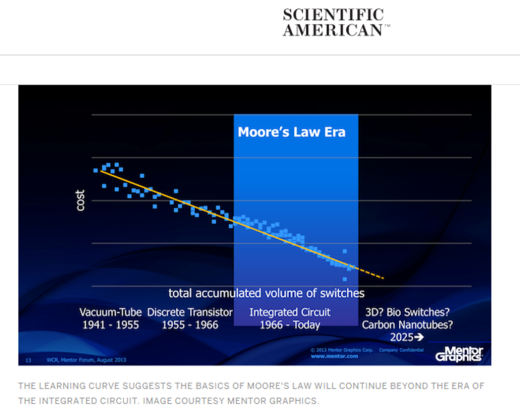Moore’s Law, the auto industry and the need for a new innovation yardstick
Any time Moore’s Law comes up in the press it’s a near certainty the reporter will imagine how other industries might evolve if the same faster/better/cheaper schedule applied. The auto industry often plays the stodgy counterfactual role in these thought experiments. Last month it was The Economist which led its article on the end of Moore’s Law with the Ferrari Daytona, the world’s fastest car in 1971, the same year Intel launched the 4004 processor. After going through the usual sketch of exponential growth in transistors (2,300 to 1.75 billion in 45 years!), the reporter noted that “[i]f cars…had improved at such rates…, the fastest car would now be capable of a tenth of the speed of light.”
Setting aside the apples-to-oranges problem with this pairing, I know The Economist is just the latest among a long list media outlets warning ominously about the end Moore’s Law, a conclusion that doesn’t appear to keep Mentor CEO Wally Rhines up at night. In an April 12 Scientific American blog post, Wally makes his case why the declining cost per switch will continue well into the future thanks to the learning curve, the theory that undergirds Gordon Moore’s famous pronouncement and that surely will outlive it. Wally was similarly optimistic when interviewed by The New York Times last fall on the topic.

This is good news in a host of contexts far beyond computers and phones, and especially when it comes to the auto industry, which is being transformed in astonishing fashion, largely due to ever more powerful and less expensive ICT. These sorts of clever comparisons to Moore’s Law always suggest that the cars are something of an innovation backwater, a laughable idea even to the most casual observer of the changing mix of cars on the roads, and not just here in tech-savvy Austin. (I’ll give you one guess as to which company was named the world’s most innovative in 2015 by Forbes.)
I’m loathe to pick too much on the press, which generally does yeoman’s work and has been disrupted more than most by Moore’s Law. Still, I can’t resist some (light hearted!) tweaking.
Hey, Economist, when will we start seeing articles where something car-related serves as the heroic benchmark of innovation rather than the stooge? Maybe something like: “Google’s self-driving cars drove more than 1 million miles over the course of seven years before the first algorithm-at-fault accident, a very minor injury-free fender bender at that. How many articles would be published without a correction being issued if the media operated with the same accuracy?”


